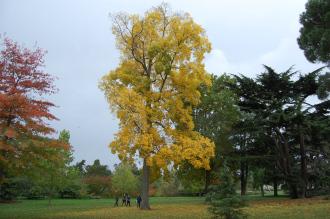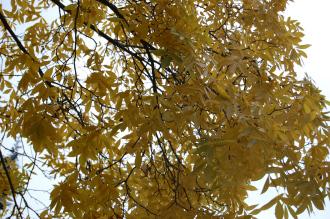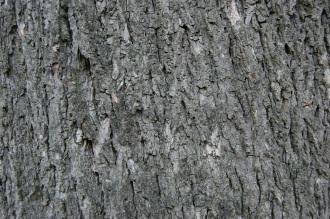
Carya cordiformis (21/10/2013, Kew Gardens, London)
Position: Full sun to light shade
Flowering period: Spring
Soil: Moist, well drained
Eventual Height: 35m
Eventual Spread: 18m
Hardiness: 4a, 4b, 5a, 5b, 6a, 6b, 7a, 7b, 8a, 8b, 9a
Family: Juglandaceae
Carya cordiformis is a deciduous tree with a cylindrical habit. Its mid green leaves are pinnate with up to 11 leaflets and up to 30cm long. Its leaflets are lanceolate with serrate margins and up to 9cm long. Its leaves turn yellow in autumn before they fall. Its grey/ brown bark is smooth when young, becoming furrowed with age. Its trunk may achieve a diameter of up to 1m. Its flowers are monoecious and wind pollinated. Its yellow/ green male flowers are catkins, appearing in groups of up to 3 and up to 10cm long. The female are very short and appear in terminal spikes. Its fruit is a drupe which is up to 3cm long, this contains a bitter nut.

Carya cordiformis Autumn Leaf (21/10/2013, Kew Gardens, London)
Carya cordiformis, commonly known as the Bitter Hickory, Bitternut or Swamp Hickory, is native to central and east USA. In its native habitat it grows along stream banks and swamps.
The etymological root of the binomial name Carya is derived from the Greek Karia, the ancient Greek name for the ‘Walnut’. Cordiformis may be derived from the Latin meaning
The landscape architect may find Carya cordiformis useful as a large specimen parkland tree with attractive autumn foliage. Care should be taken when locating this tree as the large nuts may cause damage to cars.
Ecologically, Carya cordiformis nuts are attractive to mammals.

Carya cordiformis Bark (21/10/2013, Kew Gardens, London)
Carya cordiformis prefers moist, deep, humus rich, well-drained soils. It tolerates most pH of soil. It will tolerate poor soils.
Carya cordiformis requires little maintenance.

